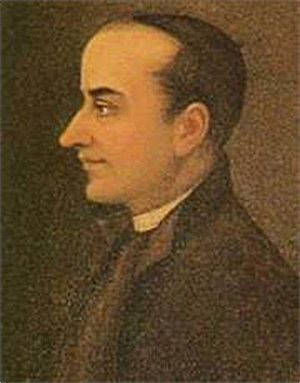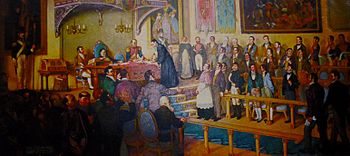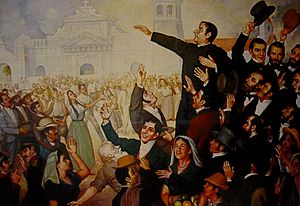José Matías Delgado facts for kids
Quick facts for kids
Presbyter, Doctor
José Matías Delgado
|
|
|---|---|
 |
|
| 2nd Political Chief of San Salvador | |
| In office 28 November 1821 – 9 February 1823 |
|
| Monarch | Agustín I (until 19 March 1823) |
| Preceded by | Pedro Barriere |
| Succeeded by | Vicente Filísola |
| President of the Constituent Assembly of the United Provinces of Central America | |
| In office 24 June 1823 – 1 July 1823 |
|
| Preceded by | Vicente Filísola (as Superior Political Chief) |
| Succeeded by | First Triumvirate |
| Personal details | |
| Born | 24 February 1767 San Salvador, Greater Mayorship of San Salvador |
| Died | 12 November 1823 (aged 56) San Salvador, Federal Republic of Central America |
| Resting place | San Salvador Cathedral 13°41′54″N 89°11′27″W / 13.6983°N 89.1908°W |
| Nationality | Salvadoran |
| Political party | Independent |
| Alma mater | University of San Carlos of Guatemala |
| Occupation | Politician, priest |
| Signature | |
José Matías Delgado y de León (born February 24, 1767 – died November 12, 1832) was a Salvadoran priest and doctor. He is known as El Padre de la Patria Salvadoreña, which means "The Father of the Salvadoran Fatherland."
He was a very important leader in the movement to make El Salvador independent from the Spanish Empire. He served as the Political Chief of San Salvador from November 28, 1821, to February 9, 1823. Later, he was the President of the Constituent Assembly of the United Provinces of Central America from June 24, 1823, to July 1, 1823.
Contents
Early Life and Education
José Matías Delgado was born on February 24, 1767, in San Salvador. At that time, San Salvador was part of the Spanish Empire. His father, Pedro Delgado y Matamoros, was from Panama. His mother, Mariana de León Mexía, was from Guatemala. José Matías had six brothers and sisters.
Delgado studied law and church law at the University of San Carlos of Guatemala. He received a special scholarship to attend. He became a doctor and was ordained as a priest in 1794. In 1808, he started rebuilding the old Parochial Church of San Salvador, which is now called El Rosario Church. The work was finished ten years later.
Leading the Independence Movement
First Cry for Freedom
In 1808, Napoleon Bonaparte invaded Spain. He removed King Ferdinand VII and put his own brother, Joseph, on the throne. The Spanish colonies in the Americas did not accept this new king. This led to strong feelings for independence.
José Matías Delgado became a key leader in San Salvador's independence movement. On November 5, 1811, he and his nephew, Manuel José Arce, led the first "Cry for Independence" in Central America. It is said that Delgado rang the bells of the Church of La Merced to call for freedom. The rebels took control of weapons and money from the government. They also removed the local Spanish governor, Antonio Gutiérrez y Ulloa, who was not popular.
The rebels held power for about a month. Then, Spanish authority was brought back from Guatemala. Delgado's brothers, Juan and Miguel, also took part in this independence movement.
Later Efforts for Independence
In 1813, Delgado was chosen to be a representative for the province in Guatemala City. He also became the director of a seminary there. He was not in El Salvador during a second uprising in 1814.

He was elected as a provincial representative again in 1820. On September 15, 1821, he was one of the people who signed the Act of Independence of Central America in Guatemala City. This was a very important step towards freedom. On November 28, 1821, he became the political chief of the province of San Salvador. This meant he was the main leader of the region.
As Head of State of El Salvador
Opposing Mexican Rule
After Central America became independent, some leaders voted to join the First Mexican Empire in January 1822. José Matías Delgado and many other Salvadorans were against this idea. On January 11, 1822, the city government of San Salvador, led by Delgado, protested this decision. On the same day, El Salvador decided to separate from Guatemala to avoid being part of the Mexican Empire.
In April 1822, Guatemalan troops, led by Colonel Manuel Arzú, took over the Salvadoran cities of Santa Ana and Sonsonate. On June 3, 1822, Arzú's troops entered San Salvador. There was a long battle with many injuries and damage to houses. The Guatemalan troops eventually left. Delgado's nephew, Colonel Manuel José Arce, helped lead the Salvadoran defenders. A few days later, Salvadoran troops took back Santa Ana, and later also Ahuachapán and Sonsonate.
Seeking US Protection
On December 2, 1822, El Salvador was worried about more attacks from Guatemala. So, they officially asked to become part of the United States. A group was sent to the United States to discuss this.
That same month, Brigadier Vicente Filisola, the Captain-General of Guatemala (who was part of the Mexican Empire), marched towards San Salvador. He entered the city on February 9, 1823. He announced that the province was now part of Mexico. This ended José Matías Delgado's time as the leader of El Salvador.
Later Life and Legacy
Central American Federation
When the Mexican Emperor Agustín de Iturbide lost power in 1823, Central America declared its full independence. Delgado was chosen as a representative for the new congress of the Federal Republic of Central America. This congress met in Guatemala starting on June 24, 1823, and Delgado was chosen to be its president.
On May 5, 1824, local leaders named him the first bishop of San Salvador. However, the Catholic Church itself did not approve this. This caused a serious disagreement with the Archbishop of Guatemala and the Vatican that lasted until Delgado's death.
In 1824, Delgado bought the first official printing press for El Salvador using public money. This press was used to print the first Salvadoran newspaper, El Semanario Político Mercantil. The first issue came out on July 31, 1824.
José Matías Delgado died on November 12, 1832, in San Salvador. When his funeral procession passed through the main square, people threw white rose petals on his coffin. He is buried at El Rosario Church.
Lasting Impact
On January 22, 1833, the National Assembly declared him Benemérito de la Patria, which means "Worthy of the Fatherland."
Many important writers and thinkers have written about Delgado's life. The first biography was published in 1878 by Rafael Reyes.
A town was named after him on October 23, 1935. The Dr. José Matías Delgado University was founded in 1977 and is located near San Salvador.
A painting of Delgado was made for the National Assembly. A marble statue of him was placed in San Salvador in 1902. Another statue was given by German, Austrian, and Swiss residents in 1913. This statue was destroyed in the 1986 San Salvador earthquake. There is also a statue of Delgado at the university named after him.
Images for kids
-
His death was marked by national mourning and bells tolling throughout the Republic, as he was one of the few prominent figures respected by Liberals and Conservatives alike. Still revered as the most tenacious patriot of his time, Delgado died on November 12, 1832. He was buried at El Rosario Church in the city of San Salvador.
See also
 In Spanish: José Matías Delgado para niños
In Spanish: José Matías Delgado para niños




